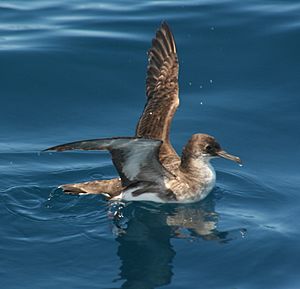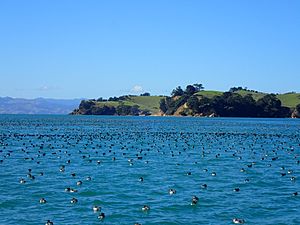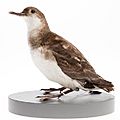Fluttering shearwater facts for kids
Quick facts for kids Fluttering shearwater |
|
|---|---|
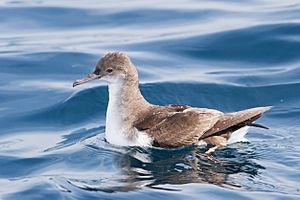 |
|
| Conservation status | |
| Scientific classification | |
| Genus: |
Puffinus
|
| Species: |
gavia
|
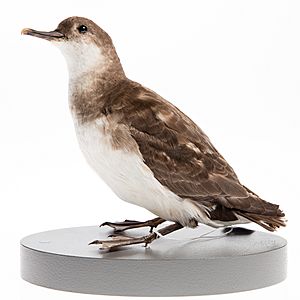
The fluttering shearwater (Puffinus gavia) is a type of seabird that belongs to the Procellariidae family. These birds live only in New Zealand. They also travel to Australia and the Solomon Islands at certain times of the year. They like to live in open seas and on rocky coasts. This bird was once known as Forster's Shearwater.
Contents
What Does the Fluttering Shearwater Look Like?
The fluttering shearwater is a medium-sized bird. It has dark brown and white feathers. Its back, neck, wings, and tail are dark brown. The color on its face and neck slowly changes to white below its eyes. Its belly, from its chin to its tail, is white. It has a dark patch on its thigh that you can see when it flies. The underside of its wings is usually white.
This bird has pinkish-brown legs and feet with dark webs. When it flies, its feet stick out past its tail. Its beak is long, thin, and dark. The tail is short and fan-shaped, with both dark brown and white colors.
How Their Feathers Change
Fluttering shearwaters start to lose their old feathers and grow new ones around late January. Their dark upper feathers can quickly turn a lighter brown. Birds that are changing feathers (from February to April) might look a bit messy and pale rusty brown.
Their Unique Voice and Flight
These birds have a very unusual and broken voice. It sounds like "ka-hek-ka-hek-ka-hek" and they usually make this sound while flying. Their flight is fast and low. They fly with quick bursts of wing beats, followed by gliding.
Size and Young Birds
Female fluttering shearwaters are a bit heavier than males. Females weigh about 302 grams, while males weigh around 243 grams. Their eggs are pure white and oval-shaped. Young birds look like the adults when they leave the nest. However, the edges of their wing feathers are a lighter color. Baby birds have very thick, dark gray, soft feathers on their backs and white fluffy feathers underneath.
Where Do Fluttering Shearwaters Live?
Their Global Home
Fluttering shearwaters are special because they only breed in New Zealand. They do this during the warmer months, from September to February. But when it's not breeding season (March to August), many of them fly to Eastern and South-Eastern Australia. Most of them stay close to their breeding areas. Scientists think that only the younger birds migrate, while the adults stay in New Zealand's rich waters. This is still being studied.
Where They Live in New Zealand
These birds build their nests on islands along the coast of New Zealand. Many large groups are found on islands in the North-East North Island. These include the Alderman Islands, Moturoa Island, Bream Islands, North-West Chicken Island, Mercury Islands, and Motuharakeke Islands. They also live on islands in the Marlborough Sounds – Cook Strait area of the South Island. Most of these islands are within 40 kilometers of New Zealand's main land.
What Kind of Places Do They Like?
Fluttering shearwaters live in both ocean and land areas. This includes coastal zones, scrubland, and forests. They are often found in warm, subtropical waters (around 24°C) that have a medium to high amount of salt (about 35%). They like inshore areas that are easy to enter, such as harbors, inlets, bays, and straits.
For breeding, they usually choose rocky, scrub-covered slopes near the top of hills. They also use cracks and holes in rocks that are far from the water's edge. This helps them take off easily when they fly.
Life Cycle and Reproduction
Breeding and Laying Eggs
We don't know a lot about how fluttering shearwaters breed. But we do know that, like most birds, they usually stay with one mate for their whole lives. They start breeding when they are 4 to 10 years old. The breeding season is from August to January.
They build their nests in burrows, which are like tunnels in the ground. The nest inside the burrow is made of dead leaves, grass, feathers, and small plant shoots. Their burrows are quite shallow and are often built in soft soil. This means that if people walk around their breeding areas, the burrows can be easily damaged. To protect them, people should be very careful and avoid these areas.
Like all birds, fluttering shearwaters lay eggs. Both male and female birds have their own reproductive parts. When they are ready to mate, the female's ovaries and the male's testes swell. The male then fertilizes the female's egg. A single egg is then laid outside the mother's body.
Some birds stay at the colonies all year. But most birds fly to the colonies in August to find a mate and prepare their burrows. After mating, females leave the colonies for one to six weeks to form their eggs. Males also leave but return to the nest site a few times. Eggs are laid from early September to mid-October. They usually lay one white egg in a burrow. Sometimes, two females might share a nest, so there could be two eggs.
Hatching and Growing New Feathers
Both male and female parents take turns sitting on the eggs. The eggs hatch in November. We don't know exactly how long the eggs take to hatch, how long the chicks stay in the nest, or when they become independent.
Parents feed the young birds daily with partly digested food. The chicks leave their colonies at night. Fluttering shearwater chicks do not leave their burrow to "exercise" their wings in the weeks before they fly. Once they fly, they are completely on their own.
Adult birds start to grow new feathers right after the breeding season ends. This happens from late summer until autumn. They get rid of old, worn-out feathers to make way for new, perfect ones.
Migration Habits
After the breeding season, many birds from the colonies fly to parts of Eastern and South-Eastern Australia. However, it is thought that only the young birds make this trip. The adult birds usually stay in New Zealand, close to their breeding colonies. They only breed in New Zealand.
How Long Do They Live?
On Burgess Island, about 63.8% of breeding attempts are successful. This means 73.3% of eggs hatch, and 88.2% of hatched chicks survive. The main reasons for problems are eggs being lost or competition with other birds. Chicks are easily attacked because parents often leave them alone after hatching, only returning to the burrow to feed them after long periods. Many young or old birds can die on land if they face bad weather or don't have enough food. Fluttering shearwaters are known to live a long time, like other birds in their family. Some of them can live for over 25 years.
What Do They Eat and Who Eats Them?
Diet and How They Find Food
Fluttering shearwaters mainly eat schooling fish like pilchards, trevally, mackerel, and sprats. They also eat small crustaceans (like krill) and squid. They catch their food in two ways: by grabbing it from the surface or by diving underwater to chase it.
Ocean currents often bring a lot of food, like krill and fish, close to the water's surface. This allows the shearwater to swim on top of the water with its head underwater to catch prey.
Diving to chase prey is another way they find food. This allows them to search a larger area. Shearwaters can chase their prey underwater by using their wings to push themselves through the water. Many birds in the Puffinus group have strong wings that help them dive deeper to catch food.
Predators and Other Threats
Maori people used to catch fluttering shearwater chicks. But in 1953, the government asked for them to be protected. The main predators of fluttering shearwaters are mammals like cats and rats. These birds have disappeared from several big breeding colonies because of introduced mammals. These include wild cats (Felis catus), house rats (Rattus rattus), and brown rats (Rattus norvegicus).
Today, most major fluttering shearwater colonies are on islands that don't have these invasive animals. There is one exception on Saddle Island, where a small group of shearwaters lives alongside Pacific rats (Rattus exulans).
Other Important Information
Human Threats to Fluttering Shearwaters
Humans are the biggest threat to fluttering shearwaters. Even though their conservation status is "least concern," their numbers are slowly going down.
Climate change is a big problem. Rising sea temperatures could harm fluttering shearwater populations. It might make their breeding season not match up with when food is available. This could mean that both chicks and adults don't have enough food, leading to many birds starving.
Fishing also affects marine animals. As more people need food, there's less food in the oceans for animals like the shearwater. Fishing boats usually don't attract fluttering shearwaters. However, because these birds often look for food in large groups, they can get caught in fishing gear in coastal areas. For example, in May 2009, 166 fluttering shearwaters died in one event at Whangaparaoa Peninsula. Too much fishing, especially with large nets called purse-seine nets, could greatly affect these birds.
Oil spills are also a danger. In October 2011, a ship called Rena got stuck in the Bay of Plenty. More than 240 fluttering shearwaters died because of the spilled oil.
Human pollution is common in the oceans. Sometimes, animals like the fluttering shearwater mistake plastic and other trash for food. Reports say that 50% of the world's seabird species have been harmed by eating marine debris. Birds around the Southern Ocean are most at risk, as this is a major area for pollution. The fluttering shearwater spends its entire life in and around these waters.
Interesting Habits
Fluttering shearwaters have a special way of flying away from the sea. They flutter their wings quickly and beat their feet. Large groups of these birds gather together and sit on the water in "rafts" during mid-December, January, and February. Sometimes, these rafts form very close to the coastline.
Moving Chicks to Start New Colonies
The number of fluttering shearwaters is currently decreasing. One reason for this decline might be predators. Usually, fluttering shearwaters return to breed near where they were born. In 1991, a long-term project began to create new colonies by moving chicks. This was done to help save the fluttering shearwaters.
From 1991 to 1996, 334 fluttering shearwater chicks were moved from Long Island to Maud Island in the Marlborough Sounds. People built fake burrows for them and fed them until they were ready to leave the new colonies.
This project showed that birds moved to a new place before they knew their original home would return to breed at the new location. The chance of birds returning to the new sites was linked to how much the chicks weighed and how long they stayed at the new colonies. Heavier chicks and those who stayed longer were more likely to come back. More research is needed to find ways to increase their weight and time spent in the new colonies. Creating new colonies is a good way to help fluttering shearwaters survive and manage endangered species.
Images for kids
-
Fluttering shearwaters waiting for the next fishing excursion near Ponui Island
-
Fluttering shearwater display at Auckland Museum
See also
 In Spanish: Pardela gavia para niños
In Spanish: Pardela gavia para niños



